Northamptonshire
NORTHAMPTON
Northampton may not be beautiful, but it still has some handsome buildings. The town and county are well known for the boot and shoemaking industry which has existed here for centuries. One of that trade was William Carey, who started life as a cobbler's apprentice at fourteen ended it as a famous linguist, orientalist and missionary pioneer.
On the corner of Guildhall Road and St Giles Street is the splendid Guildhall in late Victorian neo-Gothic style, reminiscent of London's Natural History Museum. On the first floor are statues of kings, queen and saints, while in the main hall are mural decorations of famous men in Northampton's history, many of whom we will meet elsewhere in the county and beyond: Alfred the Great, claimed by some to be the founder of the town; Oliver Cromwell who may have spent the night here before the Battle of Naseby; William Carey the shoemaker-missionary; Lawrence Washington, twice mayor in the sixteenth century and ancestor of George; and Philip Doddridge, non-conformist preacher and hymn-writer. Another mural shows Spencer Perceval, MP for the town who also has a statue in the Guildhall extension. He was one of the few Prime Ministers to hold evangelical opinions and the only one to be assassinated - shot by a madman in the lobby of the House of Commons in 1812.
At the centre of the town is the handsome All Saints Church with its pink stone portico. It was built following a great fire which destroyed most of the centre of Northampton in 1675. An inscription tells us that Charles II contributed a thousand tons of timber towards its construction, perhaps hoping to make amends for destroying Northampton's castle - of which more later.
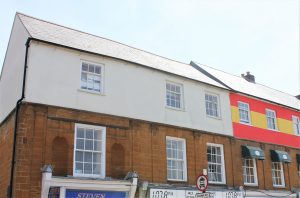
Philip Doddridge's academy
Of the gallery of heroes in the Guildhall, it is Philip Doddridge (1702-1751), who contributed most to the spiritual life of the town. From All Saints Church, a short walk up The Drapery brings us into Sheep Street. The immediate prospects are not particularly impressive and Numbers 18 to 22 (NN1 2LU) may not strike the visitor as very significant. Recently, the premises included a gents' hairdresser, a newsagent and the office of a local radio station. But look up to the first floor. Classical pilasters between the windows, and recesses which may have held busts or Grecian urns betray a more distinguished past. Formerly the town house of the Earl of Halifax, this was the home of Doddridge and his Academy for Dissenting Ministers. At a time when non-conformists were barred from the universities of Oxford and Cambridge, it was one of the most useful institutions of its day and famous across Europe. A bronze plaque on the end wall of the last house tells the story. The Academy operated from 1740 to 1751, sending out scores of young pastors and preachers. Where scholars once pored over their texts, visitors can now enjoy the cuisine of a Spanish restaurant, with the Spanish flag emblazoned on the front.
A ten-minute walk from Sheep Street brings us to the other institution directly associated with Doddridge. It is Castle Hill United Reformed Church, better known as the Doddridge Chapel (NN1 2RN). We reach it up Chalk Lane from Marefair, where there is an Elizabethan building called Hazelrigg House. It was here, according to tradition, that Oliver Cromwell spent the night before the Battle of Naseby. True or not, the citizens of Northampton supported the Parliamentary cause in the Civil War and were rewarded by Charles II at the Restoration by having part of their castle knocked down. The remainder went for the construction of the railway in 1879.

Castle Hill Chapel
However, it's an ill wind ...., as they say. In the late seventeenth century, non-conformists meeting in the Castle Hill area found the ruined castle a convenient source of building material for their new chapel. The congregation was founded in 1662 and the building erected in 1695. Philip Doddridge came as minister in 1729 and served for twenty-two years. The church is built of yellow stone like the Academy in Sheep Street and there have been extensions and alterations over the years, with a minister's house on one side and ancillary buildings at the back. Items relating to Doddridge, including his desk and chair, are preserved inside.
Philip Doddridge did not confine his ministry to Northampton's spiritual needs. He was well known for his generosity to the poor, founding a charity school in 1734 and, with his friend Dr Stonhouse, co-founding the town's first Infirmary in 1743. His book The Rise and Progress of Religion in the Soul had a profound influence on many, including William Wilberforce. Today he is remembered for several hymns including O God of Bethel and O Happy Day. Suffering a collapse in health, Doddridge went to Lisbon to recuperate but died there in 1751.
On the eastern side of the town, there is a link to another non-conformist of a very different character. This was Robert Browne (1550-1631) who is buried in the churchyard of St Giles. In a controversial career, he had the distinction of being thrown into thirty-two prisons, the final one being Northampton Gaol where he died. It is to this eccentric man that Independents or Congregationalists trace their beginnings; originally they were known as Brownists. The Congregational Union, meeting here in 1923, decided that their founder was worthy of a memorial and arranged for the erection of the monument in the churchyard. The inscription records that ... among many things obscure, one thing shone brightly; that Christ was by him exalted as head above all.
Despite his frequent incarcerations, Browne had long periods of respectable employment, including five years as master of Stamford Grammar School and forty years as rector of Thorpe Achurch, some twenty miles from here on the road to Peterborough.
PAULERSPURY
Just off the A5, the village is a gem of stone cottages and thatched roofs. William Carey was born here in 1761. In the porch of St James Church (NN12 7NE) at the west end of the village is a brass plaque commemorating Carey missionary and orientalist who died at Serampore, India, in 1834.
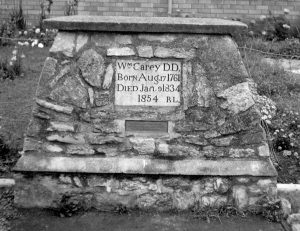
Carey memorial, Pury End
Carey began life as a cobbler and ended it as scholar translating parts of the Bible into twenty-six Indian dialects. His departure for India in 1793 is reckoned as the start of the modern missionary movement.
The grave of Carey's father Edmund Carey, who was the village schoolmaster, is a few feet away just to the right of the church porch. It carries a faint inscription Reader, time is short, prepare to meet thy God, revealing something of the spirit which sent his son to India. The Careys' cottage was actually at Pury End (NN12 7NS), a hamlet half a mile away, in what is now called Carey's Road. It was demolished in 1965 and replaced by modern houses, but a memorial cairn was built from the original stones.
PIDDINGTON and HACKLETON
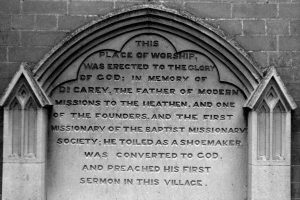
Carey memorial, Hackleton
These two unexciting villages make an unlikely setting for the conversion and nurture of a great pioneer missionary. William Carey came to Piddington at the age of fourteen, as apprentice to a shoemaker, Clarke Nicholls. Carey's cottage and that of Nicholls survived to the twentieth century - a 1923 biography has photographs of both - but they have both gone. It was here that Carey read the recently published journals of Captain Cook, which helped to inspire his vision of missionary travel. The only remaining building with a direct connection is the church of St John the Baptist where he married Dorothy Plackett on 10th June 1781.
Encouraged by John Warr, a fellow apprentice, he attended the Baptist Meeting at Hackleton where he was converted in 1779 and walked six miles to Northampton to be baptised in the River Nene. For further spiritual guidance he turned to Thomas Scott, the Bible commentator, who had succeeded John Newton as curate of Olney over the border in Buckinghamshire.
The Hackleton chapel has been replaced by the Carey Baptist Memorial Church (NN7 2AH), a rather ugly late Victorian building in red brick. A stone inscription on the wall reminds us that this was the village where Carey ...toiled as a shoemaker, was converted to God and preached his first sermon.
MOULTON
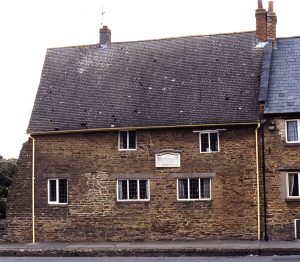
Carey's cottage, Moulton
It was to this charming village on the northern outskirts of Northampton that William Carey came to pursue his cobbler's trade. At the same time he was learning new skills as schoolmaster and preacher to a local Baptist congregation. Eventually he gave up shaping leather to shape men's souls and departed for India in 1793. Reluctantly but dutifully, his wife Dorothy went with him together with their growing family.
The Baptist congregation lives on as the Carey Baptist Church in West Street. Next to this is Carey's cottage, No. 32, adjoining a pub called The Telegraph (NN3 7SB). The door is at the back and just inside set into the wall is the trough where Carey used to soak his leather. On the outside wall a tablet records that Carey lived here from 1785 to 1789, and pays tribute to his achievements: .....shoemaker, schoolmaster, preacher, scholar and missionary pioneer. While beneath this roof, he conceived and developed the great missionary idea that changed India and awakened worldwide movements. It quotes his famous dictum Expect great things from God; attempt great things for God.
KETTERING

Carey Mission House
In the late eighteenth and early nineteenth centuries, this town saw the birth of movements, particularly associated with the Baptist Church, which were to have lasting impact in many parts of the world.
On October 2nd 1792, a group of twelve Baptist ministers sat down to discuss the proposition to send missionaries overseas. Their leader was Andrew Fuller (1754-1815), minister of the local church, and also present was William Carey, whose sermon at a Baptist conference in Nottingham earlier that year had inspired the meeting. Thus was born the Baptist Missionary Society and Carey became its first candidate. It is to this occasion that historians date the foundation of modern Protestant missions. The meeting took place in a large house in Lower Street, the home of one of Fuller's congregation. It is now called the Carey Mission House (NN16 8BG) and a bronze plaque in front describes the occasion, even recording the amount raised from a collection among the ministers - £13-2s-6d!
Immediately opposite is Chesham House, the home of Thomas Gotch, founder of the shoemaking industry in Kettering and an early supporter of Carey. While Carey worked as a shoemaker in Moulton, nurturing his vision of missionary work in India, Gotch would purchase his output of finished boots, providing him with a steady income.

Plaque recording foundation of Baptist Missionary Society
The Fuller Baptist Church in Gold Street (NN16 8JB) was built in 1860 in the Victorian Gothic style, but has an interesting Italianate frontage with tiled patterns over the arches. Its origins date back to 1666. Andrew Fuller came here as minister in 1782 and remained until his death in 1815. He is buried in a small graveyard behind the church and there is a marble plaque and stained glass window in his memory. The church has a museum which can be visited by appointment. It contains many artefacts relating to Carey, Fuller and the early history of the Baptist Missionary Society.
Yet another Kettering missionary was William Knibb (1803-1845) who was born in Market Street His birthplace is not marked but it was one of a group of shops where the pointed gable ends are separated by tall fluted chimney stacks. Knibb was apprenticed as a printer to Andrew Fuller's son. Moving to Bristol, he joined Broadmead Baptist Church and his interest in overseas work was aroused by printing missionary reports. He departed for Jamaica with his wife in 1824.
They quickly became involved in agitating against the evils of slavery despite warnings from the Baptist Missionary Society not to interfere in political affairs. In 1832, a major revolt broke out and Knibb was arrested on a charge of fomenting riot among the slaves. After seven weeks in prison, he was freed for lack of evidence. Returning to England, he was delighted to find that laws were being enacted for the complete abolition of slavery. Now protected from official interference, he went back to Jamaica to continue his work. It is reckoned that he was largely responsible for the liberation of 300,000 slaves and helped to raise money to purchase thousands of acres of land where former slaves could become freehold farmers. He personally baptised 6,000 converts and was involved in founding fifty-nine churches and missions and sixteen schools. The Kettering coat of arms shows a Negro with a broken chain for Knibb and blue-waved lines on a shield to represent the seas crossed by pioneers of the Baptist Missionary Society.
WAPPENHAM
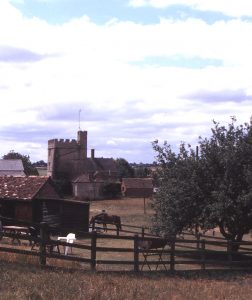
Astwell Castle Farm
On the road from Wappenham to Helmdon, a sign points us to Astwell Castle Farm, up a narrow lane to the left (NN13 5QU). The battlemented castle tower, built about 1500, is now incorporated into a working farmhouse. It is all that remains of the original castle, where Selena Hastings, later Countess of Huntingdon, was probably born in 1707. She was the daughter of the second Earl Ferrers.
Lady Huntingdon became a significant figure in the eighteenth century evangelical revival. Using her powers of patronage, she appointed several zealous preachers as her chaplains and built chapels in the leading spa towns of Bath, Brighton and Tunbridge Wells. For a time she remained within the Church of England, but eventually broke away to form a non-conformist group known as the Countess of Huntingdon's New Connexion.
BRIXWORTH and EARLS BARTON
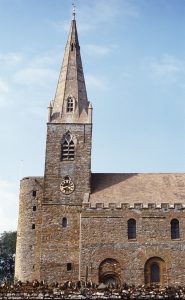
Brixworth Saxon Church
In the seventh century, King Penda of Mercia was a warlike pagan, but his son Peada responded to the preaching of early Saxon saints and became a Christian. He founded the monastery at Medeshamstede, now called Peterborough. From here Saxon monks reached out to communities along the Nene valley and two remarkable buildings survive.
On the A508 a few miles north of Northampton, the signs say Saxon church AD 680, and if they are exaggerating it is not by much. All Saints Church at Brixworth (NN3 9DF) probably dates from the time of King Offa, and was already old in the reign of Alfred the Great. It claims to be the largest building of its date north of the Alps and there are few challengers. The stair turret and spire are more recent but the main body of the church is original, with Roman bricks gleaned from local villas forming arches in the tower, nave and clerestory. In the nave, later masonry infilling has been used to frame the door and windows. The church used to stand alone on a low hill completely surrounded by fields. Today modern housing comes quite close, but sheep grazing in the churchyard help to maintain the Anglo-Saxon ambience.
Earls Barton lies to the east of Northampton and here it is the tower that is Saxon, and the nave and chancel medieval. While probably about 200 years later than Brixworth, the tower of All Saints Church (NN6 0JG) is considered one of the outstanding examples of Saxon architecture. It shows the style known as "long and short work" - large slabs of stone placed alternately flat and upright. Rising in four stages like a wedding cake, each storey of the tower has a characteristic pattern, with vertical ribs, semicircles, diamond-shaped lozenges and finally banister-like columns. The battlements on top are later. Set prominently on a mound above the village, the tower has stood like a beacon for a thousand years, and the rest of the church for not much less.
ACHURCH
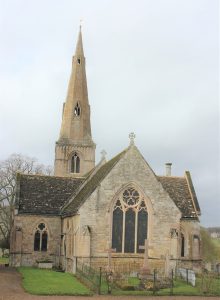
St John the Baptist, Achurch
In the rural Nene valley a few miles east of Kettering is the church of St John the Baptist (PE8 5SL), where the argumentative Robert Browne came as rector in 1591. He is remembered as the unofficial founder of "separatism" which became the Independent or Congregational church. In the turbulent years after the Reformation, Browne's teachings were regarded as heretical and dangerous, and he frequently found himself in prison. For over forty years, however, he kept a low profile within the established church at Achurch, while secretly continuing to preach separatism in a room at Thorpe Waterville.
The church has an impressive spire with lucarne windows and graves of two crusaders in the churchyard. A notice board by the entrance tells us that in a final act of defiance Browne struck a constable in a dispute over taxes. Now aged over eighty, he was carried off on a feather mattress to Northampton where he died in about 1631.
KING'S CLIFFE
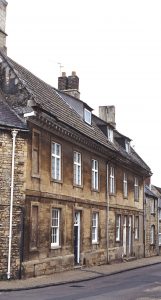
William Law's birthplace
This delightful village just west of Peterborough is built almost entirely of honey-coloured stone. A useful map and display board by the church points out places of interest. Several of these relate to William Law (1686-1761), the sage of King's Cliffe, who was born, lived, worked, died and was buried in the village.
Law is remembered for his book A Serious Call to a Devout and Holy Life, first published in 1728 and still in print. It was studied by members of John Wesley's Holy Club at Oxford, several of whom became profoundly depressed by their failure to achieve the high standards prescribed. However, they pressed on to discover that salvation was by grace not works, so Law's book pointed them indirectly to the truth.
The son of a grocer, Law was born in the handsome three-storey house, now forming numbers 8 to 12 West Street. It appears to be built from precisely fitting stone blocks with no use of mortar. After study at Emmanuel College, Cambridge, Law entered the service of the Gibbon family, becoming tutor to the father of the historian Edward Gibbon. Throughout his life he was a "non-juror", refusing to swear allegiance to the George I and remaining loyal to the Stuart succession.
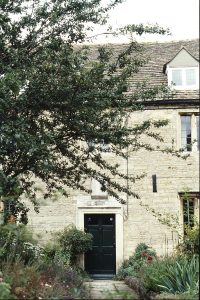
Library House, King's Cliffe
On one occasion, Law was given £1000 by a stranger in a London street, which he used to found a girls' school near King's Cliffe. For a time he lived at a house on the road to Apethorpe. It is behind a high wall opposite the Cornforth almshouses. Known as the Library House, it is privately owned but through the gate we can see the sundial on the wall and over the door is Law's quaintly phrased notice saying Books of piety are here lent to any persons of this and neighbouring towns.
In later life, Law lived at Hall Farm in Hall Yard, just beside the church (PE8 6XQ). Here in 1743 he was joined by two members of the Gibbon family, a Miss Gibbon and a Mrs Hutcheson, who became his devoted followers. The three led lives of orderly devotion and charity, entertaining beggars and keeping cows to provide milk for the poor. Law died in 1761 and is buried in a casket shaped tomb overlooking Hall Yard close by the churchyard gate. The long inscription has become almost illegible due to weathering but describes the good works of Law and his companions. Mrs Hutcheson, was later laid to rest in the same tomb.


